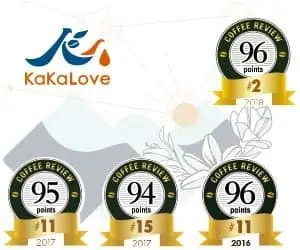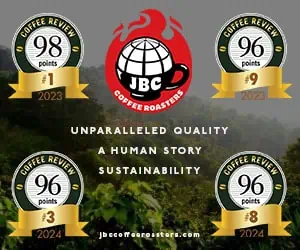India is an attractive coffee origin on several counts. India coffees all are grown in shade, often two tiers of shade, and are frequently intercropped with spices, particularly cardamom, clove, cinnamon and nutmeg. Indias often pick up intriguing aromatics from these crops, probably from having been stored and handled around them.
The large farms or estates on which India coffees are grown are organized along traditional lines with considerable sensitivity to environmental issues. Medium growing altitudes (2,000 to 4,500 feet) mean India specialty coffees are balanced, sweet, and moderate in acidity, virtues that American specialty consumers often favor. And a virtue that coffee writers in particular appreciate is the articulate and informed leadership of two individuals who interface between India coffees and the American market: Joseph John of Josuma Coffee, the leading North American importer of India coffees, and Sunalini Menon, India’s leading cupper and a vigorous spokeswoman for the India specialty coffee farmers.
On the other hand, India coffees suffer certain limitations. Moderate growing altitudes mean moderate acidity in the cup and a sometimes listless, inert profile. Disease-resistant hybrid varieties whose heritage includes a touch of flavor-suspect species robusta and liberica also may contribute to the sweet but monotoned India profile. The scourge of India coffees, the rust disease, doomed Old Chik, the original strain of arabica coffee brought to India around 1600 by legendary coffee pilgrim Baba Budan, and little of the celebrated early 20th century hybrid var. Kent has survived.
India Coffee’s Virtues Tested
Nevertheless, we can expect certain virtues from a fine India wet-processed coffee: smooth, sweet, low key but resonant, often with suggestions of spice and other exotic innuendoes.
This month’s cupping puts that expectation to the test with thirteen estate-grown India coffees. All are from the most respected growing districts of southern India and grown at altitudes averaging around 4,000 feet. All are wet-processed, meaning the fruit was removed immediately after picking. Most have been wet-processed by traditional methods, meaning the sticky fruit flesh was loosened by natural fermentation before the beans were washed by hand. (Two samples were prepared by mechanical demucilaging, meaning the fruit flesh was scrubbed off the beans by machine, an approach that some of us suspect produces a less complex cup than traditional ferment-and-wash methods.) Most come from trees of the recently developed hybrid S795 (the “S” stands for “Selection”), a cross between the admired hybrid variety Kent and a second hybrid that has a little of the taste-suspect Liberica species in its makeup. Two samples, however, were produced from trees of the original Kent variety.
When They Were Good They Were Sultry
When these coffees were good they were good as expected: sweet, round, resonant, and nuanced with sultry little whispers of spice and aromatic woods.
When they were not good, they were not good for more surprising reasons. I would have expected some of these Indias to attract lower ratings simply because they taste a bit flat or inert. But the problem was more complex: Several of the samples hinted at processing defects, taste taints that come from either too much unripe fruit (grassiness, astringency), fermented sugars, or mustiness (invasion of micro-organisms during drying or storage).
In one case, the Betta Crown Blue Pearl, the taints were overwhelming, turning the coffee virtually undrinkable. In the other cases, the defects were subtle and hardly noticeable except in the aroma and as the cup cooled. Nevertheless, these shadow defects, combined with a generally rather low-key cup, apparently doomed most of these Indias to rather low ratings.
Too low, in my opinion. I felt that several of these coffees were deserving of considerably higher ratings than they received here. Their ratings also may have suffered from the tendency of American cuppers to hold to a single kind of coffee ideal — the boldly acidy, high-toned profiles of high-grown Central America and Kenya coffees. Virtues like resonant sweetness and luxurious fruit ma
y attract American coffee consumers, but apparently fail to impress professionals.
Teetering on Taint
Nevertheless, these Indias were a touch disappointing even when held against the India ideal I sketched earlier. The intriguing spice notes were largely missing, to be replaced by more ambiguous tones teetering on taint.
It may be that these weaknesses were exacerbated by the age of the samples. All were from coffees picked and processed nine or ten months ago. In those months some of the subtler aromatics may have faded, to be replaced by baggy mustiness.
In one case, the panel was cupping coffee from the same trees and the same farm (the highest-rated Balanoor Estates and the considerably lower-rated India Mysore Plantation A var. Kent). In the case of the latter coffee, some panelists complained of a slight taint that lowered their assessment of the sample. I have to assume that these two lots of the same coffee were handled differently, processed at separate times perhaps, or stored differently.
Value and Promise
Nevertheless, I, for one, felt value and promise in these coffees. The Badra Estate sample was splendid when hot, shimmering with East-Africa-style fruit and flowers; the smooth, sweet Bababudangiri would make a fine contribution to an espresso blend in the subtle Italian mode; both the Honnamatti Estate and Balanoor Plantations are worthy of presentation as distinctive India single origins. If American cuppers could stretch their expectations a bit toward the full, sweet end of the sensory spectrum and Indian farmers tighten up their processing a bit, we might find more soft, spicy Indias on the American specialty menu.










